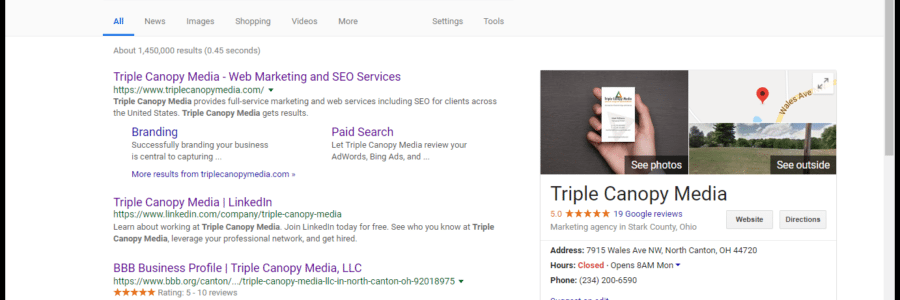Social media. Who uses it? How often do they use it? And what platforms do they use?
It’s essential to know the answers to those questions if we want to successfully craft targeted social media posts for our businesses.
The Pew Research Center survey
So let’s take a look at the latest research from the Pew Research Center, which routinely knocks it out of the park when it conducts surveys.
From Jan. 8 to Feb. 7, researchers in the Pew survey conducted telephone interviews among a national sample of 1,502 adults, 18 years of age or older, living in all 50 U.S. states and the District of Columbia. Of the respondents, 302 were interviewed on a landline telephone, and 1,200 were interviewed on a cellphone.
What did the survey conducted early this year find? It found that despite privacy and other concerns, social media use by adults is basically unchanged.
“The shares of adults who say they use Facebook, Pinterest, LinkedIn and Twitter are each largely the same as in 2016, with only Instagram showing an uptick in use during this time period,” according to the survey. (Note: There are no comparable 2016 phone survey data for YouTube, Snapchat, WhatsApp or Reddit.)
The previously steady growth in the use of social platforms in the United States during the past decade appears to be slowing, the report shows. While Facebook and YouTube have the broadest reach among adults, Instagram and Snapchat have a strong following among young adults. These findings illustrate the age-, gender-, and race-related differences in platform use that the survey documented, which we share below.
Evolving social media
But first a news update. Although social media use has remained flat, social media design – from its appearance to its features – continues to change – and here’s the latest on that. The Pew survey results hit April 10, less than one month before Facebook rolled out a new redesign for its app and website in late April.
The redesign gives both a cleaner look, more white space, more emphasis on groups, and prominent placement for “Stories” photo-sharing, according to such sources as Business Insider. Facebook says groups, which it counts at 400 million, are among the most “meaningful” ways people use the site.
Included in the Facebook news was a bit about Facebook Dating, which is set to launch in the U.S. by the end of the year. Also included is a new “Meet New Friends” feature. It will be interesting to see how these changes affect Facebook statistics when Pew conducts its next survey.
What the research shows
For now, let’s look at some statistics about social media users using the most popular platforms, as featured in the Pew survey and in an April 10 article and info-graphic on Social Media Today.
The latest survey is just one piece of useful research about social media that the Pew Research Center has conducted over the years, with the first in-depth studies on both adult and teen use of social media conducted in 2007. Find more here.
General social media statistics
- Approximately 3.04 billion social media users worldwide
- About the same number actively access social media on their mobile devices.
- 90% of these reach out to brands or retailers.
- In the U.S. 77% of people have at least one social media profile.
- Global internet users spend 135 minutes daily on social media sites.
The platforms
- 2.4 billion users
- 69% of adults use the platform
- 74% of users visit site daily
- 50% visit several times a day
- 63% male
- 75% female
- 70% white
- 70% black
- 69 Hispanic
- 84% of 25- to 29-year-olds use it
- 74% have incomes of $75K+
- 75% have some college
- 590 million members; 260 million users
- 27% of adults use the platform
- 29% male
- 24% female
- 28% white
- 24% black
- 16% Hispanic
- 44% of 25- to 29-year-olds use it
- 49% have incomes of $75K+
- 51% have college+
- 70% of users are outside the U.S.
- 326 million users
- 22% of U.S. adults
- 24% male
- 21% female
- 21% white
- 24% black
- 25% Hispanic
- 44% of 18- to 24-year-olds use it
- 31% have incomes of $75K+
- 32% have college+
- 80% access it via mobile device
- 250 million+ users
- 28% of U.S. adults
- 15% male
- 42% female
- 33% white
- 27% black
- 22% Hispanic
- 38% of 18- to 24-year-olds use it
- 41% have incomes of $75K+
- 38% have college+
- 1 billion active monthly users
- 500 million are active daily
- 37% of U.S. adults
- 31% male
- 43% female
- 33% white
- 40% black
- 51% Hispanic
- 75% of 18- to 24-year-olds use it
- Dominated by those under age 35
- Majority of users visit site daily
- 60% of 18- to 29-year-old users use the platform several times per day
- 42% have incomes of $75K+
- 43% have college+
Snapchat
- 255 million users
- 24% of U.S. adults
- 24% male
- 24% female
- 22% white
- 28% black
- 29% Hispanic
- Majority of users visit site daily
- 62% of 18- to 29-year-olds use it
- 68% of 18- to 29-year-old users use the platform several times per day
- 27% have incomes of less than $30K
- 29% have some college
YouTube
- 9 billion users
- 73% of U.S. adults use it
- 78% male
- 68% female
- 71% white
- 77% black
- 78% Hispanic
- 93% of 25- to 29-year-olds use it
- 83% have incomes of $75K+
- 80% have college+
- 51% visit site daily; that figure was 45% in 2018







 For instance, when you upload an image onto your website, give it a title using words that can help a search engine identify that image as something that rightfully accompanies your written content. Returning to the business example we discussed earlier, let’s say that you run a gourmet burger restaurant and that the image seen here depicts one of your signature items. A person can see this for what it is, but a search engine
For instance, when you upload an image onto your website, give it a title using words that can help a search engine identify that image as something that rightfully accompanies your written content. Returning to the business example we discussed earlier, let’s say that you run a gourmet burger restaurant and that the image seen here depicts one of your signature items. A person can see this for what it is, but a search engine 





 Way back in 2015, Google announced that queries conducted on its search engine using mobile devices had outnumbered those made on desktops.
Way back in 2015, Google announced that queries conducted on its search engine using mobile devices had outnumbered those made on desktops.
 Keeping with the theme of searchers asking direct questions and wanting direct answers is the concept of long-tail keywords. These are the longer and more specific phrases that people use when conducting voice searches or when they’re closer to actually making a purchase. Someone who searches for “cookware” might just be passing time. But someone who searches for a “7-inch diameter non-stick skillet” probably wants to buy that item today. As a business, the key to taking advantage of this trend is to make sure that you have specific phrases describing what you do or sell in your site’s content that can set you apart from your competition.
Keeping with the theme of searchers asking direct questions and wanting direct answers is the concept of long-tail keywords. These are the longer and more specific phrases that people use when conducting voice searches or when they’re closer to actually making a purchase. Someone who searches for “cookware” might just be passing time. But someone who searches for a “7-inch diameter non-stick skillet” probably wants to buy that item today. As a business, the key to taking advantage of this trend is to make sure that you have specific phrases describing what you do or sell in your site’s content that can set you apart from your competition.